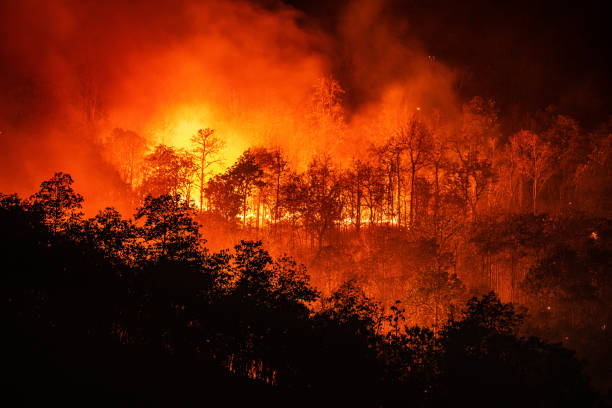When it comes to wildfire prevention and public safety, Red Flag Warnings play a crucial role. These warnings are issued by meteorological agencies to indicate potential critical fire weather conditions, making them vital tools for communities living in fire-prone areas. In this article, we will delve into the significance of Red Flag Warnings, the factors involved in their issuance, and the necessary measures to ensure safety during such conditions.
What is a Red Flag Warning?
A Red Flag Warning is a forecast warning issued by the National Weather Service (NWS) to inform firefighting agencies and the public about upcoming weather conditions conducive to wildfire ignition and rapid fire spread. These warnings are released when critical fire weather conditions are either occurring or will shortly occur due to a combination of factors.
Meteorological Conditions for Red Flag Warnings
Weather Factors
Red Flag Warnings are typically associated with a specific set of weather conditions that increase the likelihood of wildfires. These conditions include low humidity, high temperatures, and strong winds. The combination of these elements creates an environment where fires can ignite easily and spread rapidly.
Critical Fire Weather Conditions
Critical fire weather conditions are the main triggers for Red Flag Warnings. These conditions are characterized by relative humidity levels below a certain threshold (often around 15% or lower) and sustained wind speeds exceeding specific limits (typically 20 mph or higher). Additionally, drought conditions and dry vegetation contribute to the severity of these warnings.
Importance of Red Flag Warnings
Public Safety
The primary goal of Red Flag Warnings is to safeguard public safety. By alerting communities to heightened fire risks, people can take necessary precautions and evacuate if required. This proactive approach helps prevent injuries, loss of life, and property damage.
Fire Suppression and Prevention
Red Flag Warnings also aid firefighting agencies in allocating resources strategically. By anticipating potential fire outbreaks, firefighters can be positioned in high-risk areas, enabling rapid response and containment efforts.
How Red Flag Warnings are Issued
Red Flag Warnings are issued based on the analysis of various meteorological data and fire behaviour patterns. The National Weather Service, in collaboration with local fire departments and land management agencies, closely monitors weather conditions and assesses the potential for wildfires.
Understanding Fire Behavior
Fire Spreading Mechanisms
To effectively respond to Red Flag Warnings, it is essential to understand how fires spread. Fires can advance through direct flame contact, but they can also spread through flying embers, a process known as spot fires. Spot fires can ignite new blazes ahead of the main firefront, making containment efforts challenging.
Factors Affecting Fire Behavior
Several factors influence fire behaviour, including weather conditions, fuel availability, and topography. Weather plays a pivotal role, as it directly affects fuel moisture, fire intensity, and the speed at which the fire spreads.
Red Flag Warning vs. Fire Weather Watch
While both Red Flag Warnings and Fire Weather Watches indicate elevated fire weather conditions, there are differences between the two. A Fire Weather Watch is issued when critical conditions are possible but not imminent. Conversely, a Red Flag Warning signifies that critical conditions are either ongoing or expected to occur shortly.
Preparing for Red Flag Warnings
Emergency Preparedness
To be adequately prepared for Red Flag Warnings, individuals and communities should have comprehensive emergency plans in place. These plans should include evacuation routes, communication strategies, and arrangements for vulnerable populations.
Evacuation Plans
In high-risk areas, it is crucial to have evacuation plans ready. Residents should know how to evacuate safely and have designated meeting points to regroup with family members if separated.
Staying Informed During Red Flag Warnings
Official Sources
During Red Flag Warnings, it is essential to rely on official sources of information such as the NWS, local fire departments, and emergency management agencies. Social media and news outlets can also provide timely updates.
Communication Channels
Communities should establish communication channels to disseminate information quickly. This may involve text alerts, community meetings, or automated phone calls to ensure everyone is aware of the situation.
Response to Red Flag Warnings
Evacuation Procedures
When a Red Flag Warning is issued, residents must take immediate action if evacuation orders are given. Following established evacuation procedures ensures a smooth and safe evacuation process.
Firefighting Strategies
Firefighters focus on rapid response and containment when facing Red Flag conditions. Their strategies involve identifying and suppressing fires early to prevent further spread.
Community Efforts to Prevent Wildfires
Education and Awareness
Community involvement is essential in preventing wildfires. Educational campaigns and awareness programs can teach residents about fire safety, proper land management, and the importance of adhering to Red Flag Warnings.
Fire Mitigation Projects
Communities can engage in fire mitigation projects, such as clearing flammable vegetation near homes and establishing fire breaks to slow the spread of wildfires.
Reducing the Risk of Wildfires
Fuel Reduction Measures
Reducing the availability of fuels that support fire spread is critical. This can be achieved through controlled burns, selective logging, and fuel breaks.
Home Defensible Space
Creating defensible space around homes involves clearing vegetation and creating a buffer zone that helps protect properties from encroaching fires.
The Impact of Climate Change on Red Flag Warnings
Climate Trends and Fire Frequency
The frequency and intensity of Red Flag Warnings are influenced by climate change. Rising temperatures, prolonged droughts, and altered weather patterns contribute to an increased likelihood of these warnings.
Long-term Implications
Addressing the impact of climate change on Red Flag Warnings requires global efforts to reduce greenhouse gas emissions, conserve water resources, and promote sustainable land use practices.
Conclusion
Red Flag Warnings serve as crucial tools in protecting communities from wildfires. By understanding the meteorological conditions that prompt these warnings and taking appropriate measures, we can enhance public safety and minimize the devastation caused by wildfires.










